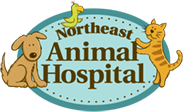Obesity – The Skinny on Fat Pets

We hear a lot about body shaming, or criticizing someone for their body shape. “Can you believe how much weight he gained after they got married?” or, “She is way too skinny. Someone should give that girl some pizza!” Opinions abound, and judgments are expressed; but what about our pets? Should we be offended if our friend jokes that our cat’s belly drags the ground? Well, that could depend on the friend! But what if our veterinarian tells us that our dog could benefit from a restricted-calorie diet? ‘Doesn’t the doctor understand that Fido is getting older and it’s harder for him to get the exercise he used to? And besides, who can say no to that face?!’
Obesity is becoming an epidemic for pets, and the excess fat that they carry around impairs their health and quality of life. There’s no doubt we love our pets, but when the love starts to show, it’s time to set our excuses aside and put our pet’s health first. But how, exactly, do you put a pet on a diet? Do you have to count calories? Keep a food diary? Make sure they get at least 3 days a week of interval training?! Happily, it’s not as complicated as when a human has some lbs to lose. Here are some simple changes you can make to help your pet win its battle of the bulge:
- Switch to reduced-calorie pet food. Whether prescribed by your vet or purchased from a retail store, the goal of a calorie-restricted diet is to cut calorie intake by about 25%. Why not just feed your pet ¾ of their normal diet? A reduced-calorie diet is designed to leave your pet still feeling full, by either reducing fat or by adding fiber to the food.
- Follow the recommended feeding instructions given either by your vet or on the food’s packaging. Allowing your pet to free feed (or have access to a bowl that’s always full) defeats the purpose of a calorie-restricted diet, i.e., eating the entire bag of reduced-fat chips!
- Skip the treats- especially table scraps. This one is probably the hardest for pet lovers, because we love to see our babies happy, but remember, there are other ways to reward your pet! Extra playtime or snuggle time, a good back scratch or belly rub, are excellent calorie-free ways to show we care. If the only way to our pet’s heart is truly through their belly, then we can offer healthy snack options such as broccoli, a piece of carrot or banana, a slice of watermelon or apple (without the seeds of course), a green bean or a few peas. Just make sure that the pieces are small enough not to pose a choking hazard and steer clear of chocolate, onions, garlic, grapes, raisins, or anything with xylitol in it.
- Up the exercise. Take your dog on an extra walk, or increase the distance you go. Play fetch or another game that gets your dog moving. For cats, laser pointers, or toys that encourage play are good ways to get your cat active. Slim Cat Ball feeders are a great tool to make your cat work for its food. If you have a few extra minutes, try tossing your pet’s kibble one by one and make them chase it down–who says they can’t have fast food?!
By changing a few of our pet’s habits –and our own, we can help extend our pets’ lives by up to 1 ½ years. Now that’s worth every effort!
